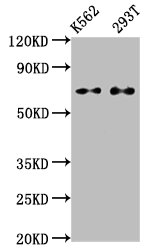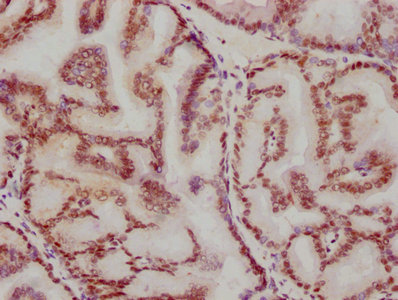
Western Blot Positive WB detected in: K562 whole cell lysate, 293T whole cell lysate All lanes: ATF2 antibody at 1.2microg/ml Secondary Goat polyclonal to rabbit IgG at 1/50000 dilution Predicted band size: 55, 36, 24, 49, 53, 14, 25, 16 KDa Observed band size: 70 KDa
ATF2 Recombinant Monoclonal Antibody

CSB-RA002270A0HU
ApplicationsWestern Blot, ELISA, ImmunoHistoChemistry
Product group Antibodies
ReactivityHuman
TargetATF2
Overview
- SupplierCusabio
- Product NameATF2 Recombinant Monoclonal Antibody
- Delivery Days Customer20
- ApplicationsWestern Blot, ELISA, ImmunoHistoChemistry
- CertificationResearch Use Only
- ClonalityMonoclonal
- Clone ID3D12
- ConjugateUnconjugated
- Gene ID1386
- Target nameATF2
- Target descriptionactivating transcription factor 2
- Target synonymsactivating transcription factor 2 splice variant ATF2-var2; cAMP response element-binding protein CRE-BP1; cAMP responsive element binding protein 2, formerly; cAMP-dependent transcription factor ATF-2; CREB2; CREB-2; CRE-BP1; cyclic AMP-dependent transcription factor ATF-2; cyclic AMP-responsive element-binding protein 2; HB16; histone acetyltransferase ATF2; TREB7
- IsotypeIgG
- Protein IDP15336
- Protein NameCyclic AMP-dependent transcription factor ATF-2
- Scientific DescriptionTranscriptional activator which regulates the transcription of various genes, including those involved in anti-apoptosis, cell growth, and DNA damage response. Dependent on its binding partner, binds to CRE (cAMP response element) consensus sequences (5-TGACGTCA-3) or to AP-1 (activator protein 1) consensus sequences (5-TGACTCA-3). In the nucleus, contributes to global transcription and the DNA damage response, in addition to specific transcriptional activities that are related to cell development, proliferation and death. In the cytoplasm, interacts with and perturbs HK1- and VDAC1-containing complexes at the mitochondrial outer membrane, thereby impairing mitochondrial membrane potential, inducing mitochondrial leakage and promoting cell death. The phosphorylated form (mediated by ATM) plays a role in the DNA damage response and is involved in the ionizing radiation (IR)-induced S phase checkpoint control and in the recruitment of the MRN complex into the IR-induced foci (IRIF). Exhibits histone acetyltransferase (HAT) activity which specifically acetylates histones H2B and H4 in vitro. In concert with CUL3 and RBX1, promotes the degradation of KAT5 thereby attenuating its ability to acetylate and activate ATM. Can elicit oncogenic or tumor suppressor activities depending on the tissue or cell type.
- ReactivityHuman
- Storage Instruction-20°C or -80°C
- UNSPSC12352203

